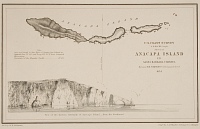Anacapa Island | ||
| Number: | 2 | |
| Date: | 1854 | |
| Medium: | etching | |
| Size: | 134 x 227 mm | |
| Signed: | no | |
| Inscribed: | no | |
| Set/Publication: | U.S. Coast Survey, 1854 | |
| No. of States: | 1 | |
| Known impressions: | 16 | |
| Catalogues: | K.App.1; M.app. 1 | |
| Impressions taken from this plate (16) | ||
TECHNIQUE
Lochnan discusses the draughtsmanship in this etching:
'There is greater sureness and looseness of line in the published plate than in the experimental The Coast Survey Plate. Whistler's love of picturesque detail led him to elaborate the subject and texture beyond the requirements of topographical drawing. He experimented with reflections, and used a system of minute hachures, zigzags and dots to describe the cliff face, which anticipate the linear vocabulary of the "French Set" etchings of 1858. The skill with which he plied the needle, and the wide variety of linear conventions which he successfully employed, indicate with what care he must have studied the etchings in the Haden collection.' 6
However, it is important to note that the work was done by three people, including Whistler, and reflects the style and techniques taught at the U.S. Coast Survey as well as lessons in topographical drawing as taught at West Point. The original survey was done in 1854 by Lieut. T. H. Stevens, a naval officer, who later served on the Union side during the Civil War. Whistler was one of the three engravers of the subject. The other two (J. Young and C. A. Knight) have not been identified.
Stylistically it is impossible to distinguish Whistler's work in it from that of his colleagues; but the Pennells thought:
'Whistler, most likely, etched the view of the eastern extremity of the island, for many lines on the rocky shore resemble the work in the French series, and also the two flights of birds which, though they enliven the design, have no topographical value. This plate was finished and published. There is said to be a third plate, a chart of the Delaware River, but we have never seen it and can find out nothing about it.' 7
PRINTING
The majority of impressions are printed in black ink on wove paper. The size of the edition is not known, and though a number of impressions, recorded in this catalogue, are in public art collections, there are more in libraries and naval establishments.
